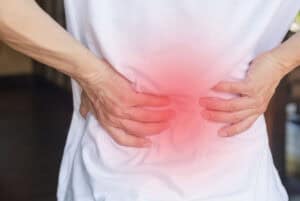
Spinal stenosis is a medical condition in which pressure on the spinal nerves causes various symptoms, including muscle weakness, numbness and tingling, leg pain, and back pain. Most often, the symptoms are low back pain and leg pain that worsens with activity.
The spinal cord is located within the bony spine (spinal column) and carries messages between the brain and body. Nerves branch out from the spinal cord to bring these messages to various parts of your body.
The spinal canal is a hollow space that runs through your spine. It protects your spinal cord and nerves. Too much pressure on the spinal cord or nerves can cause problems with movement and sensation (called neuropathy). If there’s too much pressure on the nerves in your back, it may also cause pain.
Table of Contents
If you have spinal stenosis, you may have trouble moving your legs or arms and lose strength or stamina when walking or climbing stairs. You may feel like something is pulling on one side of your body when you bend over.
The symptoms of spinal stenosis can vary depending on where they are located in the spine:
Further, the symptoms may vary from person to person but commonly include:
The causes of spinal stenosis can be divided into two categories:

The most common cause of herniated discs is ageing, which can also happen after a back injury or a fall. You may have one or more discs in your spine affected by this problem.
The bulging disc puts pressure on the nerves that travel through your spine and cause pain and weakness in your legs and arms.
Spinal stenosis also occurs due to abnormal narrowing (stenosis) of one or more spaces within the spinal canal that contain spinal nerves or spinal discs, resulting in pressure on these structures.
The bones forming this area may be abnormally shaped or misshapen, causing them to rub against each other as you move.
The following risk factors may increase your chances of developing spinal stenosis:
Spinal stenosis is diagnosed based on your signs and symptoms, imaging tests and sometimes a physical examination, which will check for tenderness in the lower back and thighs, leg strength and reflexes.
Your Spinal Stenosis doctor may use one or a combination of these tests to help diagnose your condition:
These are the most recommended options for spinal stenosis treatment:
This option is usually considered when pain has not responded to conservative treatment. The goal of surgery is to remove the narrow portion of bone or tissue that is compressing the nerve root.
Possible surgical treatments include:
Steroids are often injected into the spinal canal to reduce inflammation in people with spinal stenosis who do not respond to medications or want faster relief from symptoms.
Steroids may be injected directly into the spinal canal, which relieves pressure on the nerves inside it, or into the epidural space between the bones of your spine and your dura mater (the outermost layer of your spinal cord).
Epidural steroid injections usually have few side effects but can sometimes cause bleeding or infection at the injection site, as well as headaches and dizziness — especially when standing up quickly.
Recovery from spinal stenosis surgery usually takes two to three months. The length of time it takes to recover varies from person to person and depends on many factors, including age, health, and duration of symptoms.
You will have to avoid strenuous activity and heavy lifting during this period. The first three to four days after surgery are the most critical, so your doctor may request you to stay in the hospital during this time.
The pain from spinal stenosis can be mild to severe and debilitating. It is important to visit a doctor and get a check-up to explore your treatment options. Visit the C.K Birla hospital near you or book an appointment with for a consultation.
1. Where does spinal stenosis occur?
Spinal stenosis occurs most often in the lower (lumbar) spine. It can also occur in the neck (cervical).
2. Who gets spinal stenosis?
Spinal stenosis most often affects people over age 50, although it can occur at any age.
3. Can spinal stenosis cause permanent paralysis?
The answer to this question is both yes and no. Some patients with spinal stenosis may present with permanent paralysis. However, in most cases, the paralysis is temporary, lasting for a few weeks or months.
4. When is spinal stenosis surgery considered?
Surgical treatment of spinal stenosis is usually recommended for patients who have pain and other symptoms that affect their daily activities. Surgery may also be used to relieve compression on nerves in cases where there is no improvement with nonsurgical treatments.
5. Is spinal surgery safe?
In rare cases, surgery is not considered safe because of other medical conditions or because the patient might be too frail from age or illness to tolerate the procedure well.
You may also be recommended not to have surgery if you have cancer or another serious condition that could be worsened by the procedure.